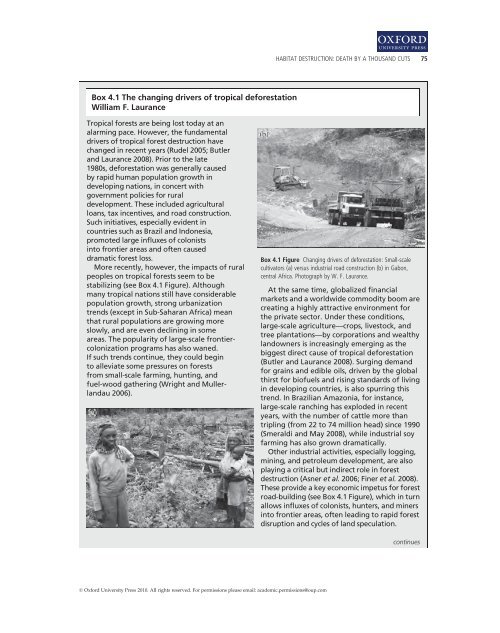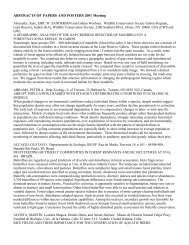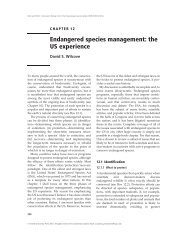Habitat Destruction: Death by a Thousand Cuts - Society for ...
Habitat Destruction: Death by a Thousand Cuts - Society for ...
Habitat Destruction: Death by a Thousand Cuts - Society for ...
- No tags were found...
Create successful ePaper yourself
Turn your PDF publications into a flip-book with our unique Google optimized e-Paper software.
1<br />
HABITAT DESTRUCTION: DEATH BY A THOUSAND CUTS 75<br />
Box 4.1 The changing drivers of tropical de<strong>for</strong>estation<br />
William F. Laurance<br />
Tropical <strong>for</strong>ests are being lost today at an<br />
alarming pace. However, the fundamental<br />
drivers of tropical <strong>for</strong>est destruction have<br />
changed in recent years (Rudel 2005; Butler<br />
and Laurance 2008). Prior to the late<br />
1980s, de<strong>for</strong>estation was generally caused<br />
<strong>by</strong> rapid human population growth in<br />
developing nations, in concert with<br />
government policies <strong>for</strong> rural<br />
development. These included agricultural<br />
loans, tax incentives, and road construction.<br />
Such initiatives, especially evident in<br />
countries such as Brazil and Indonesia,<br />
promoted large influxes of colonists<br />
into frontier areas and often caused<br />
dramatic <strong>for</strong>est loss.<br />
More recently, however, the impacts of rural<br />
peoples on tropical <strong>for</strong>ests seem to be<br />
stabilizing (see Box 4.1 Figure). Although<br />
many tropical nations still have considerable<br />
population growth, strong urbanization<br />
trends (except in Sub‐Saharan Africa) mean<br />
that rural populations are growing more<br />
slowly, and are even declining in some<br />
areas. The popularity of large‐scale frontiercolonization<br />
programs has also waned.<br />
If such trends continue, they could begin<br />
to alleviate some pressures on <strong>for</strong>ests<br />
from small‐scale farming, hunting, and<br />
fuel‐wood gathering (Wright and Mullerlandau<br />
2006).<br />
(a)<br />
(b)<br />
Box 4.1 Figure Changing drivers of de<strong>for</strong>estation: Small‐scale<br />
cultivators (a) versus industrial road construction (b) in Gabon,<br />
central Africa. Photograph <strong>by</strong> W. F. Laurance.<br />
At the same time, globalized financial<br />
markets and a worldwide commodity boom are<br />
creating a highly attractive environment <strong>for</strong><br />
the private sector. Under these conditions,<br />
large‐scale agriculture—crops, livestock, and<br />
tree plantations—<strong>by</strong> corporations and wealthy<br />
landowners is increasingly emerging as the<br />
biggest direct cause of tropical de<strong>for</strong>estation<br />
(Butler and Laurance 2008). Surging demand<br />
<strong>for</strong> grains and edible oils, driven <strong>by</strong> the global<br />
thirst <strong>for</strong> biofuels and rising standards of living<br />
in developing countries, is also spurring this<br />
trend. In Brazilian Amazonia, <strong>for</strong> instance,<br />
large‐scale ranching has exploded in recent<br />
years, with the number of cattle more than<br />
tripling (from 22 to 74 million head) since 1990<br />
(Smeraldi and May 2008), while industrial soy<br />
farming has also grown dramatically.<br />
Other industrial activities, especially logging,<br />
mining, and petroleum development, are also<br />
playing a critical but indirect role in <strong>for</strong>est<br />
destruction (Asner et al. 2006; Finer et al. 2008).<br />
These provide a key economic impetus <strong>for</strong> <strong>for</strong>est<br />
road‐building (see Box 4.1 Figure), which in turn<br />
allows influxes of colonists, hunters, and miners<br />
into frontier areas, often leading to rapid <strong>for</strong>est<br />
disruption and cycles of land speculation.<br />
continues<br />
© Ox<strong>for</strong>d University Press 2010. All rights reserved. For permissions please email: academic.permissions@oup.com






